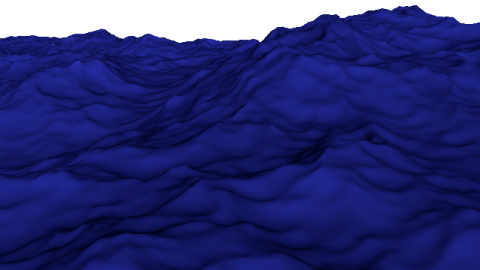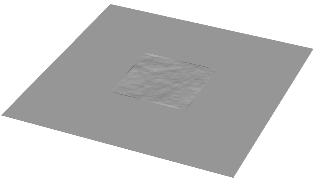Use the BOSS Spectral Wave solver to create wind-driven waves on a water surface. You can create effects ranging from calm water to hurricane conditions.

To apply the solver, see Add and edit BOSS solvers.
- Enable
- Turn off to mute the effect without removing it from the scene.
Global Attributes
- Start Frame
- The first frame for which the solver has an effect.
- Periodic
- Repeats the wave pattern in space. This lets you use a smaller patch to deform a larger mesh plane, but the repetition of the tile may be noticeable.


Periodic on versus off
- Patch Size X (m), Patch Size Z (m)
-
The horizontal dimensions of water surface to compute, centered on the world origin. This is not necessarily the same as the size of the solver's input mesh:
- If the patch and mesh are different sizes and you want to use the cached EXR files as maps, then you will need to adjust the UV projection on the final mesh to match the effect properly.
- If the patch is bigger than the mesh, then portions of the patch beyond the mesh's dimensions get calculated but are not visible. This can waste computation, and also waste disk space for cached files. However, a larger patch allows you to animate the input mesh to reveal different regions of the patch, as in the surface around a moving boat. In addition, large patches are necessary for big swells with long wavelengths in very rough water.
- If the patch is smaller than the mesh, then make sure that Periodic is on so that the whole mesh is deformed.
- If you are combining BOSS Spectral Wave with BOSS Wave Solvers, then it is best to set the patch size to the same size as the mesh. This is because the BOSS Wave Solver's results get squashed or stretched to fit the mesh, and will not align with the spectral results if they are different sizes.
Like other dynamics systems, BOSS uses a scale of 100:1 compared to Maya. When Maya's Linear Working Units preference is set to the default value of centimeter, BOSS interprets 1 grid unit as 1 meter. To use a different scale, you can set Space Scale, change Gravity m/s2, or do both.
- Space Scale
- Linear scaling factor of the patch in each of the X and Z directions. Values between 0 and 1.0 shrink the result, and values above 1.0 expand it. If the waves move too quickly or slowly after scaling, you can adjust Gravity m/s2 or use an expression to add a multiplier to the Time input.
- Frequency Spectra Type, Directional Spectra Type
- Select from a variety of published spectra for frequency and direction. In general, the combination of TMA for Frequency Spectra Type and Jonswap for Directional Spectra Type is a good choice for open oceans, but you can experiment with other options for variety. Note that the available models are based on measurements made under different conditions, and not every combination is suitable for any given situation. You may need to adjust Wave Height, Space Scale, and other attributes depending on the spectra types.
- Seed
- The value used to initialize the pseudo-random number generator. Change this value to generate different results with the same overall characteristics.
- Resolution X, Resolution Z
- The resolution of the grid used for calculating wave heights. This also controls the resolution of the EXR files used for caching. Higher values allow for more detail, but take longer to compute and require more disk space for caching. Matching the aspect ratio of the patch ensures even sampling with no squashing or stretching in either direction.
Simulation Attributes
- Gravity m/s2
- The acceleration due to gravity. The default of 9.8 represents the strength of gravity at the earth's surface in m/s2. Smaller values produce higher waves that move more slowly, and larger values produce lower waves that move more quickly. You can adjust this value to change the scale.
- Ocean Depth (m)
- The water depth used to calculate wave motion. Waves tend to be longer, taller, and slower in shallow water.
- Wave Height
- An artificial multiplier for the wave height. Use values between 0.0 and 1.0 to decrease the wave height, and values above 1 to increase it.
- Use Horizontal Displacement
- Displaces the mesh's vertices horizontally as well as vertically. This results in waves with sharper, less rounded shapes. It also produces caches that are suitable for vector displacement maps because there are offsets in all 3 axes.
- Wave Size
- Controls the amount of horizontal displacement. Adjust this value to avoid self-intersections in the output mesh.
- Capillary Size (cm)
- The maximum wavelength of capillary waves (smaller, faster ripples that are propagated by surface tension and can sometimes be seen on top of the larger waves that are propagated by gravity). Capillary waves are typically visible only at small scales and high resolution, so in many cases you can leave this at 0.0 to avoid unnecessary computation.
- Drift Velocity in X (m/s), Drift Velocity in Z (m/s)
- Modifies the wave motion so that it behaves as if the water was moving with the specified velocity. This allows you to make waves on top of flowing water, like on a river or current.
- Short Scale Cutoff (m), Long Scale Cutoff (m)
- The minimum and maximum wavelengths to include in the computation.
- Time
- The time at which to evaluate the waves. Normally this is connected directly to the scene time, but you can break the connection and use expressions or other controls to slow or speed the wave motion.
Wind Attributes
- WindSpeed (m/s)
- The speed of the wind that generates the waves. A light breeze might be around 2 m/s, and a hurricane as much as 30 m/s or higher (but note that such a high wind speed requires a very large patch in order to include the longest and tallest waves).
- Wind Direction (degrees)
- The direction of the wind that generates the waves.
- 0 is the –X direction.
- 90 is the –Z direction.
- 180 is the +X direction.
- 270 is the +Z direction.
- Wind Fetch Distance (km)
- The distance over which the wind has been applied to the water surface. Over small distances, waves tend to be shorter, lower, and slower. Above a threshold distance (which depends on wind speed, ocean depth, and other factors), the waves are fully developed and their overall characteristics do not change significantly.
Reflection Waves Attributes
- Use Colliders
- Creates reflections of the waves that collide with any influences (Boss Geo Properties and Boss EXR Influences).
- Reflection Height
- A multiplier for the height of reflected waves. Use values above 1.0 to increase the height, and values between 0.0 and 1.0 to decrease it.
- Reflection Size
- A multiplier for the amount of horizontal displacement of reflected waves. Adjust this value to avoid self-intersections in the output mesh.
- Reflection Decay Width
- Controls the width of a region at the border of the domain where reflected waves are suppressed. This avoids reflections from the domain border. The values represent a fraction of the patch size, so for example, 0.1 means 10% of the patch size along each border.
- Reflection Decay Alpha
- Controls the smoothness of the wave suppression along the borders of the patch. Values that are too high can cause visible artifacts.
- Reflection Friction
- A damping factor for the speed of reflected waves. A value of 0.0 lets waves propagate freely, and a value of 1.0 dampens them almost immediately.
- Reflection Drift Factor
- A multiplier for the amount of Drift Velocity in X (m/s) and Drift Velocity in Z (m/s) applied to reflected waves.
- Reflection Wind Factor
- A multiplier for the amount of WindSpeed (m/s) applied to reflected waves.
- Reflection Capillary Size (cm)
- The maximum wavelength of ripples for reflection to occur.
Foam Attributes
- Enable
- Generates maps representing foam when caching the solver's output. See Generate BOSS foam maps.
- Foam Diffusion Rate
- Controls how quickly foam spreads and diminishes.
- Cusp Scale
- Controls the amount of foam.
- Cusp Min, Cusp Max
- Specifies the range of cusp values where foam is created.
- Use Speed, Speed Min, Speed Max
- Limits foam creation to regions where the speed is in the specified range.
Cache Attributes
You can use the tokens <project>, <scene>, <object>, <influence>, <frame>, and <f> for defining cache folders and file names. You can also specify tokens using the csh style, for example, $frame.
When you save a cache using tokens, a copy of the fully resolved path is also stored in the scene and used for playing the cache back. This means that the path to the cache is not lost if you save the scene under a new name or in a different project. If you later rewrite the cache files, the current values of the tokens are used and the resolved path is updated.
- Use Cache
- Reads from the cache files instead of recomputing the effect as you play back.
- Export Cache
- Writes cache files as you play back. You can turn this on manually to continually overwrite the cache files as you play back and adjust values.
- Cache Folder
- The location of all cache files for the solver, including foam and velocity if used. Omit the final "/" character when editing paths manually.
- Cache Name
- The file name for the main wave cache.
- Cache Velocity
- Create cache files for velocity.
- Velocity Cache Name
- The file name for the velocity cache
- Foam Cache Name
- The file name for the foam cache
Diagnostics
- Debug
- Sets the verbosity of messages printed in the
Output Window.
- 0 = No messages.
- 1 = Error messages only.
- 2 = Error and warning messages.
- 3 = Error, warning, and information messages.
